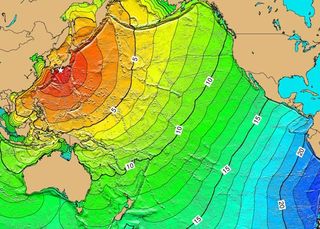Chernobyl-Scale Disaster Very Unlikely In Japan, Experts Say

Amid conflicting reports coming out of Japan on the current status of nuclear reactors there, U.S. nuclear scientists say that while an accident of Chernobyl proportions is not at all likely, there are risks involved.
"The Chernobyl accident spread radioactive material over a large area, but this was due to a massive fire of graphite in the reactor. The reactor in Japan does not use graphite in the core," Peter Caracappa, a nuclear engineer at Rensselaer Polytechnic Institute, told LiveScience. [Images of Japan Disaster]
The Fukushima and Chernobyl facilities also differ greatly in design. "The Japanese reactor also has a containment building designed to contain the products of an accident," Caracappa wrote in an e-mail. "The Chernobyl reactor did not have one."
A buildup of heat and pressure around the nuclear fuel rods at the Fukushima Daiichi plant (about 160 miles, or 260 kilometers, north of Tokyo) could melt the steel vessel housing them, the scientists explained. That would flood the concrete containment room with radioactive material. But radioactivity would only be released to the outside environment in the case of a containment failure.
"That's very unlikely," said Kent Hansen, an MIT nuclear systems engineer. "I'm not going to say it definitely will not happen, because who knows what a 9.9 magnitude earthquake right under the containment building would do," Hansen said, referring to the possibility that an even more powerful quake could hit the area. "But melting of the pressure vessel that surrounds the nuclear core would not damage the containment room in and of itself." (A nuclear meltdown is a term for what happens when a nuclear reactor core overheats and "melts.")
Neil Todreas, another MIT nuclear scientist who specializes in thermal hydraulic aspects of nuclear systems under accident conditions, concurred. "The containment will contain all significant radioactivity inside it," Todreas told LiveScience.
If a meltdown at Fukushima Daiichi's nuclear reactor No. 1 does occur, and the containment room around it gets flooded with radioactive material, there are procedures in place to gradually and safely decontaminate it, Hansen said.
Sign up for the Live Science daily newsletter now
Get the world’s most fascinating discoveries delivered straight to your inbox.
Radioactive cesium, a byproduct of uranium fission, has been detected in and around the reactor facility. But that radiation leak was not caused by containment failure. Though iodine-131 so far hasn't been detected, there's still concern about it.
The radiation leak that did occur at the Fukushima Daiichiplant earlier today (March 12) was not caused by containment failure. "Radioactivity has been released by the plant in the form of steam, which has some degree of radioactivity, to control and reduce the pressure in the containment," Todreas wrote in an e-mail.
The explosion did not appear to damage the containment room, according to news reports.
The pressure buildup resulted from cooling system malfunctions at the facility after nuclear reactors were turned off during yesterday's 8.9-magnitude earthquake. Water could not be pumped through the nuclear core fast enough to dissipate residual heat emanating from the fuel rods.
"Water existing in the reactor vessel, which covers the fuel rods, gets heated up and boils," Todreas wrote. "The resulting steam causes a pressure buildup."
He added that the degree of radioactive decay, a process that produces the heat, decreases over time.
Natalie Wolchover was a staff writer for Live Science from 2010 to 2012 and is currently a senior physics writer and editor for Quanta Magazine. She holds a bachelor's degree in physics from Tufts University and has studied physics at the University of California, Berkeley. Along with the staff of Quanta, Wolchover won the 2022 Pulitzer Prize for explanatory writing for her work on the building of the James Webb Space Telescope. Her work has also appeared in the The Best American Science and Nature Writing and The Best Writing on Mathematics, Nature, The New Yorker and Popular Science. She was the 2016 winner of the Evert Clark/Seth Payne Award, an annual prize for young science journalists, as well as the winner of the 2017 Science Communication Award for the American Institute of Physics.
Most Popular


